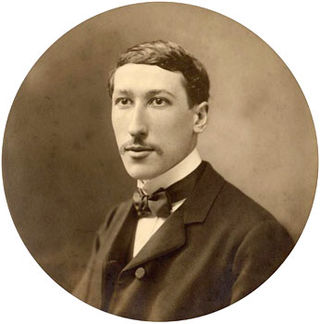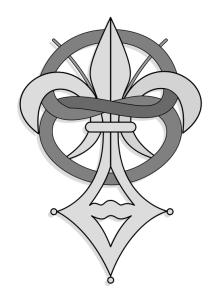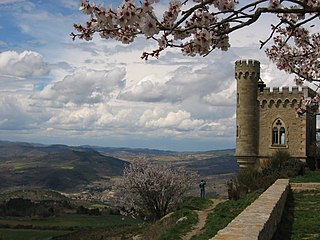Pierre Plantard de Saint-Clair was a French technical artist, best known for being the principal fabricator of the Priory of Sion hoax, by which he claimed from the 1960s onwards that he was a male-line Merovingian descendant of Dagobert II and the "Great Monarch" prophesied by Nostradamus. Today in France, he is commonly regarded as a con artist.

René Jean-Marie-Joseph Guénon, also known as Abdalwahid Yahia, was a French intellectual who remains an influential figure in the domain of metaphysics, having written on topics ranging from esotericism, "sacred science" and "traditional studies" to symbolism and initiation.
René Adolphe Schwaller de Lubicz, was a French Egyptologist and mystic who popularized the idea of sacred geometry in ancient Egypt during his study of the art and architecture of the Temple of Luxor in Egypt, and his subsequent book The Temple In Man. Many of de Lubiscz's claims have been rejected by mainstream Egyptologists, but embraced by promoters of "alternative Egyptology".

Traditionalism, also sometimes known as Perennialism, posits the existence of a perennial wisdom or perennial philosophy, primordial and universal truths which form the source for, and are shared by, all the major world religions. Historian Mark Sedgwick identifies René Guénon, Ananda Coomaraswamy, Julius Evola, Mircea Eliade, Frithjof Schuon, Seyyed Hossein Nasr and Alexandr Dugin to be the seven most prominent Traditionalists.
Noël Corbu is best known as a former restaurateur in the Southern French village of Rennes-le-Château who, between 1955 and 1962 circulated the story that the 19th-century French priest Bérenger Saunière discovered the treasure of Blanche of Castile. Corbu changed his story about Saunière in 1962.
Philippe Louis Henri Marie de Chérisey, 9th marquess de Chérisey was a French writer, radio humorist, surrealist and supporting actor.
Géraud-Marie de Sède, baron de Liéoux was a French author, writing under the nom-de-plume of Gérard de Sède, and a member of various surrealist organizations. He was born into an aristocratic family from Comminges, the son of Marcel Alfred Gustave de Sède, baron de Liéoux and Aimée de Sède de Liéoux 's first cousins, once removed. De Sède's father was the senior editor of the Catholic newspaper Le Courrier du Pas-de-Calais owned by the De Sède family.

Joseph Alexandre Saint-Yves, Marquis d’Alveydre was a French occultist who adapted the works of Fabre d'Olivet (1767–1825) and, in turn, had his ideas adapted by Gérard Encausse alias Papus. His work on "L'Archéomètre" deeply influenced the young René Guénon. He developed the term Synarchy—the association of everyone with everyone else—into a political philosophy, and his ideas about this type of government proved influential in politics and the occult.
Jean-Pierre Laurant is a French historian of esotericism.

Jean Borella is a Christian philosopher and theologian. Borella's works are inspired by Ancient and Christian Neoplatonism, but also by the Traditionalist School of René Guénon and Frithjof Schuon.
Jean-François Gautier was a French philosopher, musicologist, etiopath, journalist, writer and editor.

The Prieuré de Sion, translated as Priory of Sion, was a fraternal organisation founded in France and dissolved in 1956 by Pierre Plantard in his failed attempt to create a prestigious neo-chivalric order. In the 1960s, Plantard began claiming that his self-styled order was the latest front for a secret society founded by crusading knight Godfrey of Bouillon, on Mount Zion in the Kingdom of Jerusalem in 1099, under the guise of the historical monastic order of the Abbey of Our Lady of Mount Zion. As a framework for his grandiose assertion of being both the Great Monarch prophesied by Nostradamus and a Merovingian pretender, Plantard further claimed the Priory of Sion was engaged in a centuries-long benevolent conspiracy to install a secret bloodline of the Merovingian dynasty on the thrones of France and the rest of Europe. To Plantard's surprise, all of his claims were fused with the notion of a Jesus bloodline and popularised by the authors of the 1982 speculative nonfiction book The Holy Blood and the Holy Grail, whose conclusions would later be borrowed by Dan Brown for his 2003 mystery thriller novel The Da Vinci Code.
Jean Hani (1917-2012) was a French philosopher and Traditionalist author, and a professor of Greek civilization and literature at the University of Amiens.

Rennes-le-Château is a commune approximately 5 km south of Couiza, in the Aude department in the Occitanie region in Southern France.
Xavier Accart is an historian of ideas, specializing in René Guénon. His field of research lies at the crossroads of the history of spirituality, anthropology of religion and literary creation.

Abbé Jean-Jacques-Henri Boudet, is best known for being the French Catholic parish priest of Rennes-les-Bains between 1872 and 1914 and for being the author of the book La Vraie langue celtique et le cromleck de Rennes-les-Bains, first published in 1886.
Père Émile-Henri-Guillaume Hoffet belonged to the Missionary Oblates of Mary Immaculate, who became famous during the 1960s when he became implicated in the subject matters of Rennes-le-Château and the Priory of Sion.

The Hiéron du Val d'Or was a Catholic esoteric secret society in France, which existed from 1873 until 1926. It was founded by a Jesuit Victor Drevon and the half-Basque, half-Russian Alexis de Sarachaga. It was allied to concepts of royalism and was culturally conservative; it sought to erect a Catholic hermetic freemasonry, contrary to the anti-clerical freemasonry of Grand Orient de France and was particularly devoted to Christ the King.
Eugène Albert Puyou de Pouvourville was a French orientalist, mystic, poet, and translator.
René Alleau was a French author, historian and consulting engineer. The focus of his numerous works are symbology and alchemy, the occult and secret societies. As well as his own works, he contributed articles in these fields to the Encyclopædia Universalis.








